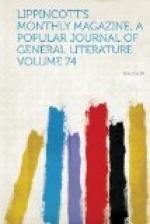The department of Villa Rica produces excellent cotton, which is cultivated, however, only in infinitesimal quantities. Indigo, called by the natives anil, grows wild. The tobacco of the district is especially renowned, and in the Cordillera, the tops of which compose the background of the beautiful region lying to the east of the town, mate is grown successfully. The very name of the Cordillera of Caaguazu bears testimony to the abundance of the yerba, caa meaning mate in the Guaranian language, and guazu, “great” or “much.” As seen from the elevation on which Villa Rica stands, this mountain-range, twelve leagues distant, stretches along the horizon an undulating mass of blue. The intervening space nearer the town is filled with beautiful forests, while beyond are vast plains, the monotony of which is broken by lagoons and clumps of palms. The population of the region around Villa Rica is estimated at fifteen thousand. There are good opportunities here for immigrants, for Nature, like a fruitful mother, holds ample treasures in her bosom, which need only a little well-directed labor to bring the tiller of the soil his reward. Laborers receive a sum equal to about twenty cents of our money for a day’s work, and carpenters about fifty cents. Food of coarse quality, however, is supplied by the employer.
Owing to the decrease in the population—which, as before stated, is composed almost altogether of women and children—and the simple life of the people, the importations into Paraguay are limited to a few articles. Of these products of foreign industry, the observer may see exposed for sale in the shops coarse cotton goods and hardware of an inferior quality, both manufactured in England; boots and shoes, the former of which are worn chiefly, of Buenos Ayres make; and ready-made garments of linen and poor cloths. The imported liquors and articles of food are principally a small quantity of sugar, lard, wine of an execrable quality, and Hamburg gin, together with a few boxes of candles and some oil and soap. To this list of imports must be added the inevitable Chinese fire-crackers, without which noisy accessories no Paraguayan holiday would be complete. Throughout South America a passion for fire-crackers and fireworks prevails; and as an example of this mania, M. Forgues relates that when the Argentine troops were on their return to Buenos Ayres after the close of the war, great preparations were made by the authorities to greet them on their arrival at three o’clock in the afternoon with a great display of fireworks. There was a delay in the coming of the troops, however, and so, to satisfy the people, the fireworks were let off a half hour after the appointed time, although the soldiers had not yet made their appearance. Still the troops delayed, and the populace, satiated with pageantry, retired to their homes and to bed. About eleven o’clock at night a tumult of trumpets, cymbals




